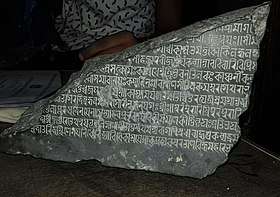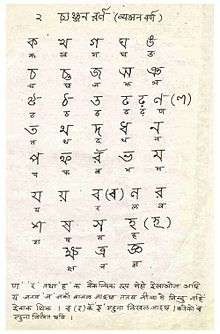Tirhuta
The Tirhuta or Mithilakshar script was the primary historical script for the Maithili language, as well as one of the historical scripts for Sanskrit. It is believed to be originated in the 10th century CE, but its use declined over years of neglect by the Bihar government. It is very similar to Bengali–Assamese script, with most consonants being effectively identical in appearance. For the most part, writing in Maithili has switched to the Devanagari script, which is used to write neighboring Central Indic languages to the west and north such as Hindi and Nepali, and the number of people with a working knowledge of Tirhuta has dropped considerably in recent years.

| Tirhuta Mithilakshar | |
|---|---|
| Type | |
| Languages | Maithili, Sanskrit |
Time period | c. 13th century–present day[1] |
Parent systems | |
Sister systems | Bengali–Assamese, Odia |
| Direction | Left-to-right |
| ISO 15924 | Tirh, 326 |
Unicode alias | Tirhuta |
Unicode range | U+11480–U+114DF Final Accepted Script Proposal |
History and current status
Before 14th CE, Tirhuta was exclusively used to write Sanskrit, later Maithili was written in this script. Despite the near universal switch from Tirhuta to the Devanagari script for writing Maithili, some traditional pundits still use the script for sending one another ceremonial letters (pātā) related to some important function such as marriage. Metal type for this script was first produced in the 1920s, and digital fonts in the 1990s.[1]
The 2003 inclusion of Maithili in the VIIIth Schedule of the Indian Constitution, having accorded official recognition to it as a language independent of Hindi, there is a possibility that this might lead to efforts to re-implement Tirhuta on a wider basis, in accord with similar trends in India reinforcing separate identities. However, currently, only Maithili in the Devanagari script is officially recognized.
Signs of the script
Consonant letters
Most of the consonant letters are effectively identical to Bengali–Assamese. The Unicode submission, for example, only bothered to create new graphic designs for 7 of the 33 letters: ⟨jh, ṭ, ḍh, ṇ, l, ś, h⟩.
| Sign | Transcription | ||
|---|---|---|---|
| Image | Text | IAST | IPA |
| 𑒏 | ka | /kə/ | |
| 𑒐 | kha | /kʱə/ | |
| 𑒑 | ga | /gə/ | |
| 𑒒 | gha | /gʱə/ | |
| 𑒓 | ṅa | /ŋə/ | |
| 𑒔 | ca | /t͡ʃə/ | |
| 𑒕 | cha | /t͡ʃʱə/ | |
| 𑒖 | ja | /d͡ʒə/ | |
| 𑒗 | jha | /d͡ʒʱə/ | |
| 𑒘 | ña | /ɲə/ | |
| 𑒙 | ṭa | /ʈə/ | |
| 𑒚 | ṭha | /ʈʱə/ | |
| 𑒛 | ḍa | /ɖə/ | |
| 𑒜 | ḍha | /ɖʱə/ | |
| 𑒝 | ṇa | /ɳə/ | |
| 𑒞 | ta | /t̪ə/ | |
| 𑒟 | tha | /t̪ʱə/ | |
| 𑒠 | da | /d̪ə/ | |
| 𑒡 | dha | /d̪ʱə/ | |
| 𑒢 | na | /nə/ | |
| 𑒣 | pa | /pə/ | |
| 𑒤 | pha | /pʱə/ | |
| 𑒥 | ba | /bə/ | |
| 𑒦 | bha | /bʱə/ | |
| 𑒧 | ma | /mə/ | |
| 𑒨 | ya | /jə/ | |
| 𑒩 | ra | /rə/ | |
| 𑒪 | la | /lə/ | |
| 𑒫 | va | /ʋə/ | |
| 𑒬 | śa | /ʃə/ | |
| 𑒭 | ṣa | /ʂə/ | |
| 𑒮 | sa | /sə/ | |
| 𑒯 | ha | /ɦə/ | |
Vowels
| Independent | Dependent | Transcription | |||
|---|---|---|---|---|---|
| Image | Text | Image | Text | IAST | IPA |
| 𑒁 | a | /а/ | |||
| 𑒂 | 𑒰 | ā | /а:/ | ||
| 𑒃 | 𑒱 | і | /і/ | ||
| 𑒄 | 𑒲 | ī | /і:/ | ||
| 𑒅 | 𑒳 | u | /u/ | ||
| 𑒆 | 𑒴 | ū | /u:/ | ||
| 𑒇 | 𑒵 | ṛ | /r̩/ | ||
| 𑒈 | 𑒶 | ṝ | /r̩ː/ | ||
| 𑒉 | 𑒷 | ḷ | /l̩/ | ||
| 𑒊 | 𑒸 | ḹ | /l̩ː/ | ||
| 𑒋 | 𑒹 | ē | /е:/ | ||
| 𑒺 | e | /е/ | |||
| 𑒌 | 𑒻 | аі | /аі/ | ||
| 𑒍 | 𑒼 | ō | /о:/ | ||
| 𑒽 | о | /о/ | |||
| 𑒎 | 𑒾 | аu | /аu/ | ||
Other signs
| Image | Text | Name | Notes |
|---|---|---|---|
| 𑒿 | candrabindu | marks the nasalization of a vowel | |
| 𑓀 | anusvara | marks nasalization | |
| 𑓁 | visarga | marks the sound [h], which is an allophone of [r] and [s] in pausa (at the end of an utterance) | |
| 𑓂 | virama | used to suppress the inherent vowel | |
| 𑓃 | nukta | used to create new consonant signs | |
| 𑓄 | avagraha | used to indicate prodelision of an [a] | |
| 𑓅 | gvang | used to mark nasalization |
Numerals
Tirhuta script uses its own signs for the positional decimal numeral system.
| Image | ||||||||||
|---|---|---|---|---|---|---|---|---|---|---|
| Text | 𑓐 | 𑓑 | 𑓒 | 𑓓 | 𑓔 | 𑓕 | 𑓖 | 𑓗 | 𑓘 | 𑓙 |
| Digit | 0 | 1 | 2 | 3 | 4 | 5 | 6 | 7 | 8 | 9 |
Image gallery
The first two images shown below are samples illustrating the history of Tirhuta. The first is the sacred sign of Ganesha, called āñjī, used for millennia by students before beginning Tirhuta studies. Displayed further below are images of tables comparing the Tirhuta and Devanagari scripts.
Unicode
Tirhuta script was added to the Unicode Standard in June 2014 with the release of version 7.0.
The Unicode block for Tirhuta is U+11480–U+114DF:
| Tirhuta[1][2] Official Unicode Consortium code chart (PDF) | ||||||||||||||||
| 0 | 1 | 2 | 3 | 4 | 5 | 6 | 7 | 8 | 9 | A | B | C | D | E | F | |
| U+1148x | 𑒀 | 𑒁 | 𑒂 | 𑒃 | 𑒄 | 𑒅 | 𑒆 | 𑒇 | 𑒈 | 𑒉 | 𑒊 | 𑒋 | 𑒌 | 𑒍 | 𑒎 | 𑒏 |
| U+1149x | 𑒐 | 𑒑 | 𑒒 | 𑒓 | 𑒔 | 𑒕 | 𑒖 | 𑒗 | 𑒘 | 𑒙 | 𑒚 | 𑒛 | 𑒜 | 𑒝 | 𑒞 | 𑒟 |
| U+114Ax | 𑒠 | 𑒡 | 𑒢 | 𑒣 | 𑒤 | 𑒥 | 𑒦 | 𑒧 | 𑒨 | 𑒩 | 𑒪 | 𑒫 | 𑒬 | 𑒭 | 𑒮 | 𑒯 |
| U+114Bx | 𑒰 | 𑒱 | 𑒲 | 𑒳 | 𑒴 | 𑒵 | 𑒶 | 𑒷 | 𑒸 | 𑒹 | 𑒺 | 𑒻 | 𑒼 | 𑒽 | 𑒾 | 𑒿 |
| U+114Cx | 𑓀 | 𑓁 | 𑓂 | 𑓃 | 𑓄 | 𑓅 | 𑓆 | 𑓇 | ||||||||
| U+114Dx | 𑓐 | 𑓑 | 𑓒 | 𑓓 | 𑓔 | 𑓕 | 𑓖 | 𑓗 | 𑓘 | 𑓙 | ||||||
| Notes | ||||||||||||||||
References
- Pandey, Anshuman (5 May 2011). "N4035: Proposal to Encode the Tirhuta Script in ISO/IEC 10646" (PDF). Working Group Document, ISO/IEC JTC1/SC2/WG2. Archived (PDF) from the original on 13 December 2016.
- Salomon, Richard (1998). Indian Epigraphy. p. 41.
- Daniels, Peter T. (January 2008). "Writing systems of major and minor languages". Cite journal requires
|journal=(help)








